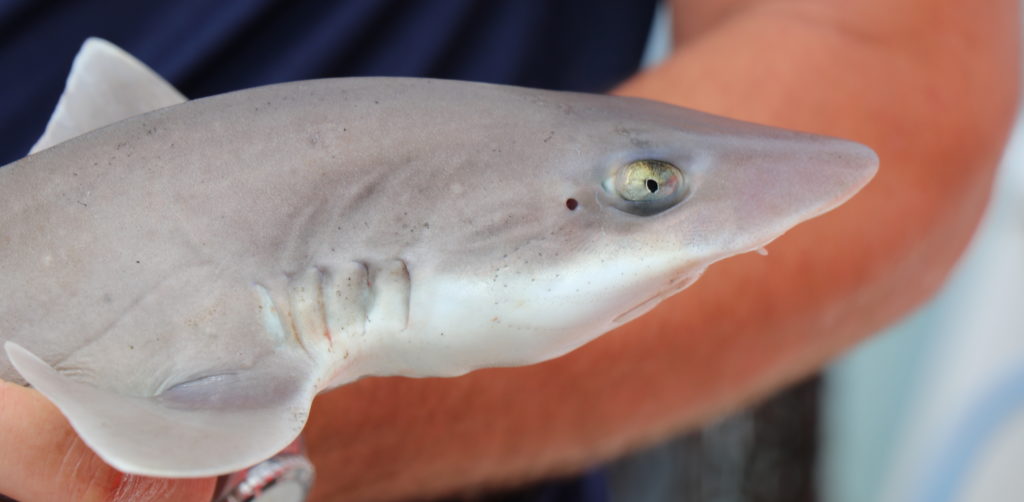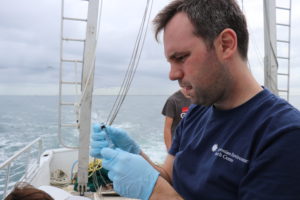by Mollie McNeel

Smooth dogfish shark (Mustelus canis), one of four species Smithsonian scientists are tagging and tracking along the Atlantic. (Mollie McNeel)
Sharks. They’re everyone’s favorite underwater enemy. Between nerve-wracking dramas like Jaws to stories about prehistoric mega-sharks, we have all but made the shark species a completely fictionalized being. But scientists at the Smithsonian Environmental Research Center (SERC) are hoping to change that.
Charles “Chuck” Bangley, a marine ecologist at SERC, travels up and down the East Coast catching and tagging four species of sharks found in the Chesapeake Bay and along the Atlantic: smooth dogfish sharks (Mustelus canis), bull sharks (Carcharhinus leucas), blacktip sharks (Carcharhinus limbatus) and dusky sharks (Carcharhinus obscurus).
The team of researchers is looking to understand more about these sharks’ movements and what areas of habitat are favorable to each species, explains Bangley. But it has another major focus: public outreach.
Sharks are often seen as fearsome predators who strike without warning, making many people believe that all sharks are dangerous to humans. But these scientists are working to swap the Jaws-inspired fear with fascination.
“People are always interested to know where sharks are and whether or not they’re near their beach house or in the areas where they used to swim as a kid,” says Bangley. “There’s still that fear, but it’s being replaced with curiosity.”

SERC marine biologist Chuck Bangley holds a syringe with lidocaine, a local anesthetic scientists use when inserting tags in sharks. (Photo: Mollie McNeel)
To help foster this curiosity, Bangley heads out on the water in search of the four species he’s tagging. Once the team catches a shark, the scientists flip it onto its back, putting it into a nonresponsive state, numb the area with lidocaine and make a small incision where they insert a small, black, cylindrical tracker. After implanting and activating the tracker, Bangley stitches the shark up and releases it back into the water—all in under five minutes.
“We tag these sharks and we want to see where they go and what types of waters they are drawn to,” says Bangley. “We want to look at potential shark habitat and known shark habitats in relation to highly populated areas, closed-off areas, areas of high fishing activity or areas of offshore development.”
By creating maps out of the data they receive, scientists hope to help inform both policy makers and the public on which areas these sharks are inhabiting and why it’s in our best interest to keep them there.
This kind of info would offer a huge leg up for conservation efforts. Policymakers are often unable to conserve threatened sharks due to the lack of appropriate data on shark movements and behavior—data which tagging and tracking work can provide. These data can help determine whether marine protected areas are large enough or in the right locales to adequately protect sharks. They can also reveal “hot spots” for shark activity that policymakers can prioritize for protection.
“This knowledge helps limit the areas that end up being closed off to other uses of the ocean while still protecting the species,” says Bangley. “It ultimately advances our goal of harmonious living between humans and wildlife.”
Shark tagging can offer real benefits to humans in other areas as well, such as fishing and even tourism. The fishing industry is way ahead of scientists in understanding where the sharks and fish are, according to Bangley.
“With a lot of this data we are really just catching up to what the fishermen know now, because they’re out on the water much more often than us,” explains Bangley. But more concrete knowledge of shark migration patterns can help fishermen avoid getting their nets bitten by sharks’ razor-sharp teeth. Sharks are commonly captured accidentally as “by-catch” and chew through fishing nets, delaying fishing time and leading to a loss of overall catch.

Graduate student Mollie McNeel holds up an Atlantic sharpnose shark on a shark tagging expedition in North Carolina. (Photo: Mollie McNeel)
Meanwhile, as almost every aquatic ecosystem is home to some shark species, divers and wildlife enthusiasts will pay good money to view sharks in their natural habitats.
Shark-based tourism provides economic benefits that can support sustainable tourism ventures, using income from the activity costs. Some governments even receive additional revenue through permit, entry or tag fees. By tagging sharks and therefore knowing where they are during various times of the season, it makes sightings more reliable and allows the industry to grow.
The scientists involved in this project believe that having multiple ways people can access information on sharks and the tagging process is the best way to reach them. Therefore, they often go out into the community giving presentations on shark and have information readily available online.
On SERC’s website and the Movement of Life Initiative page, viewers can find information on each species of shark being tagged, more information on the project as a whole and an interactive map following one very lively juvenile blacktip shark. There is a big emphasis on maps, explains Bangley, because everyone wants to see where the animals are and follow them as they’re moving around.
In the future, the scientists hope to make the online aspects more interactive and enable tracking in real time, with maps that allow visitors to scroll in, see exactly where a shark is, what species it is and how deep it was swimming.
“I think the more information the public has about these creatures, the more they will begin to realize there’s a lot more going on here than just their ability to bite,” says Bangley.
Learn more about shark research at the Smithsonian Environmental Research Center:
Intern Logs: Tagging Sharks in the Sunshine State
Jawshank Redemption: Understanding shark behavior through science
Video: Following the Movement of Life – Tagging Sharks and Rays

